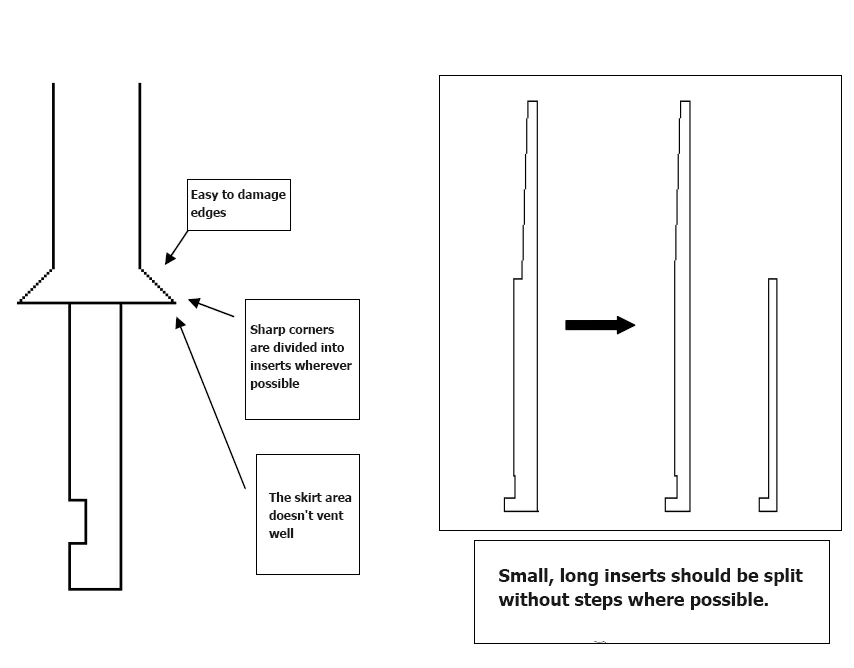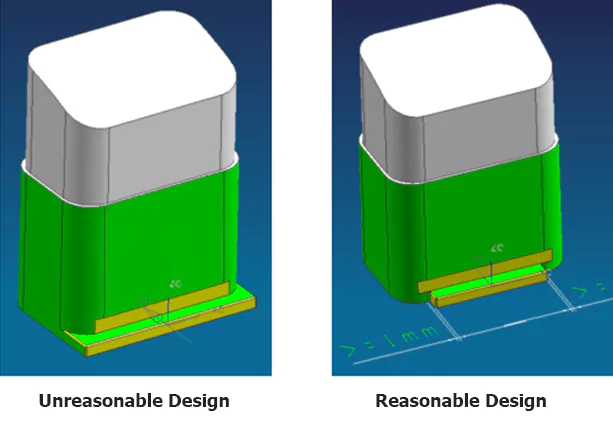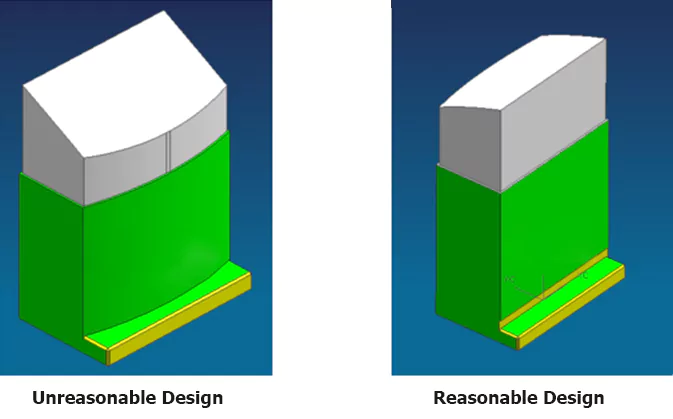Mold inserts, often referred to by various names such as inlays or embedments, play a pivotal role in the mold-making process. These specialized components, designed to be embedded within the mold’s core, can adopt diverse shapes, including square, circular, or flat forms. Just like all mold components, the precision required for these inserts is of the utmost importance. Typically crafted based on specific mold needs, these inserts highlight the meticulous attention to detail and customization that goes into every mold.
Key Advantages of Utilizing Mold Inserts in the Manufacturing Process
Enhanced Ventilation through Precise Gaps
One of the primary benefits of mold inlays is their ability to facilitate better ventilation within the mold. The precise gaps that these embedments offer ensure that trapped air can easily escape, preventing potential defects in the final product.
Simplifying Mold Processing
In the realm of injection molding, certain intricate areas, often referred to as “deep bone positions,” present significant challenges for tooling. Traditional methods, such as Electrical Discharge Machining (EDM), although effective, are notably time-consuming. This is where mold embedments come into play. By incorporating these specialized components, manufacturers can not only reduce the complexity of the machining process but also enhance ventilation. Moreover, when it comes to conserving specific sections of the mold, having the flexibility to detach individual inlays makes the task considerably more straightforward.
Prolonging Mold Lifespan
Typically, areas of a mold that require the integration of inlays are those susceptible to wear and tear. Think of regions with thin steel or sharp edges. The beauty of mold embedments is their replaceability. Should an inlay sustain damage, it can be swiftly swapped out, ensuring the mold’s longevity and consistent performance.
Efficient Temperature Conduction
While molds generally employ designed water channels for cooling, there are instances where certain sections might be inaccessible to these channels. In such scenarios, mold inlays, especially those made from materials with superior thermal conductivity, like beryllium copper, serve as excellent heat dissipators. This ensures that the mold maintains an optimal temperature, leading to flawless end products.
By integrating mold embedments into the manufacturing process, businesses can achieve a harmonious blend of efficiency, durability, and quality in their products.
Limitations and Considerations of Mold Inserts
While mold inlays or embedments offer a plethora of advantages in the manufacturing process, it’s essential to acknowledge that they come with their set of challenges. Here’s a closer look at some of these limitations:
Assembly Complexity
Incorporating mold embedments can sometimes complicate the assembly process of the mold. This added complexity might require specialized skills or additional time to ensure the mold is correctly assembled.
Risk of Material Overflow
Around the periphery of the inlays, there’s a heightened risk of material overflow, which can lead to imperfections in the final product, such as unwanted edges or protrusions.
Potential Cost Implications
Opting for a mold structure that heavily relies on embedments might sometimes escalate the design and machining expenses, thereby increasing the overall cost of the mold.
Impact on Cooling Channel Design
An excessive number of embedments can interfere with the design of the mold’s cooling channels. This can compromise the mold’s ability to maintain optimal temperatures during the manufacturing process.
Structural Integrity Concerns
Over-reliance on inlays can sometimes affect the core strength of the mold, especially if the embedments are not strategically placed or if their design is not in harmony with the mold’s overall structure.
From an efficiency standpoint, breaking down a large mold into smaller embedment components and processing them separately can save significant time. Generally, there are two types of inlays: through-inlays and blind-inlays. For smaller embedments, the Y-CUT wire-cutting method with a positioning platform is often employed. For larger ones, especially those exceeding dimensions of 60×60, the blind-inlay method with a threaded connection is preferred. While this method might pose machining challenges, it ensures the mold’s robustness.
Inlays have become a common structural component in molds. Despite their limitations, their benefits are undeniable. When designing a mold, it’s crucial to evaluate which areas necessitate embedments and which can do without them. It’s also worth noting that areas with inlays might exhibit visible inlay marks or lines. Therefore, during the mold review process, it’s essential to ensure that the client is aware of and accepts these marks. At Prototool, we always prioritize transparent communication with our clients to ensure their satisfaction with the end product.
Key Design Considerations for Mold Embedments
Mold inlays, often referred to as mold embedments or mold inserts, play a pivotal role in the mold-making process. Their design and placement can significantly influence the efficiency and quality of the final product. Here are some essential design considerations to keep in mind:
Techniques for Segmenting Embedments
Rounded Corners for Embedments: When segmenting the embedments, it’s advisable to round off the edges as much as possible. This is primarily because wire-cutting techniques cannot produce perfect internal right angles. Ideally, a radius (R) ranging between 0.3 to 1.0 is recommended for optimal results.
Decomposition of Grooves and Protrusions: Grooves, protrusions, and other intricate features should be broken down into separate embedments whenever possible. Especially for protruding features, it’s essential to segment the head and ensure proper ventilation.
Designing for Challenging Areas: Areas with sharp angles or edges that are difficult to fill and are prone to trapping air or scorching should be designed as embedments. This approach not only simplifies the molding process but also ensures a higher-quality output.
Balanced Clamping during Wire Cutting: When using wire cutting techniques, the workpiece should be clamped on both sides to ensure balanced stress during the machining process. The clamping width should be at least 5mm for optimal stability.

Designing the Embedment’s Mounting Platform
Avoiding Rounded Corners: The design of the embedment’s mounting platform should steer clear of rounded corners to facilitate wire cutting of these corners.

Opt for Regular Surfaces: While it might be tempting to design the mounting platform on irregular surfaces, it complicates the machining process. It’s more efficient to design them on regular straight surfaces.

Space Optimization: To conserve space and ensure a streamlined design, the mounting platform should avoid areas with pins, screws, and water seals. This approach not only makes the mold more compact but also optimizes the available space for other essential components.
Prototool: Where Every Detail Matters in Mold Making
Mold inserts are important, but they are really an insignificant part of the mold structure. A good mold-making company will not miss any detail in a mold and will use their expertise to fabricate the mold to the best of their ability. At Prototool, we recognize the nuanced importance of every component, no matter how small. Our profound understanding of mold embedments, combined with state-of-the-art technology and a dedicated team, ensures that every mold we produce meets the highest standards of quality and precision. When you partner with Prototool, you’re not just investing in a mold; you’re securing excellence, durability, and unparalleled craftsmanship.










